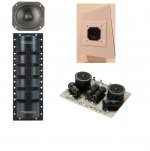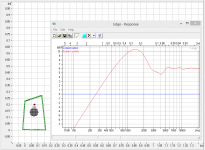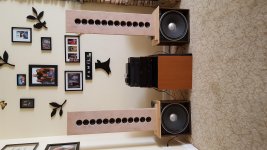Hey Anyone,
This thread is for an easy, inexpensive open baffle design. That has NO scientific mathematical model. I want to assemble it from some parts I already have and one I need to buy. It is an open baffle mini speaker. The woofer is a Tymphany LAT 250 bass driver. The upper frequencies will be handled by a Vifa TC9FD 3 1/2" full range driver. The Vifa will be mounted on a trapezoidal baffle like the one pictured. (Just because it looks cool.) The crossover will be a Parts Express subwoofer crossover. Its an 8 ohm crossover at 150hz. (I would probably upgrade the caps in the crossover.) The LAT has two 4 ohm voice coils on either end of the assembly. I intend to run the LAT voice coils in series out of phase with each other. One pushes the other pulls. OR pad the woofer to match the low efficiency of the full range and raise its impedance.
Any thoughts?
This thread is for an easy, inexpensive open baffle design. That has NO scientific mathematical model. I want to assemble it from some parts I already have and one I need to buy. It is an open baffle mini speaker. The woofer is a Tymphany LAT 250 bass driver. The upper frequencies will be handled by a Vifa TC9FD 3 1/2" full range driver. The Vifa will be mounted on a trapezoidal baffle like the one pictured. (Just because it looks cool.) The crossover will be a Parts Express subwoofer crossover. Its an 8 ohm crossover at 150hz. (I would probably upgrade the caps in the crossover.) The LAT has two 4 ohm voice coils on either end of the assembly. I intend to run the LAT voice coils in series out of phase with each other. One pushes the other pulls. OR pad the woofer to match the low efficiency of the full range and raise its impedance.
Any thoughts?
Attachments
Last edited:
Cool looking or not, this speaker design (as stated) has a serious flaw. Because of the response from the open baffle, the higher frequencies will be something like 6+dB louder than the upper bass with a peak around 1kHz and then a roll off below that at 6dB/oct. This assumes that the driver has infinite low extension, so any droop from the driver itself needs to be added on top of the baffle response.
Adding the woofer below 150 Hz won't really make up for the response hole that you will have between 200Hz and 800Hz (about 3 octaves). Unless you can cut the peak at 1kHz and correct for the drooping response of the OB you will not get very accurate sound from this speaker. This can certainly be done, but you will need more circuitry than the crossover that you mentioned.
I simulated the response you will get if the TC9 is mounted in the baffle shape you pictured and attached it for reference.
Adding the woofer below 150 Hz won't really make up for the response hole that you will have between 200Hz and 800Hz (about 3 octaves). Unless you can cut the peak at 1kHz and correct for the drooping response of the OB you will not get very accurate sound from this speaker. This can certainly be done, but you will need more circuitry than the crossover that you mentioned.
I simulated the response you will get if the TC9 is mounted in the baffle shape you pictured and attached it for reference.
Attachments
So what would be a better baffle design?
There is a relationship between the baffle response and the largest dimension (width/height) of an open baffle that controls where the "peak" in the response is located and where the response starts to fall off (below the peak). Larger baffles move the peak lower and smaller ones move it higher. When smaller drivers are put on larger baffles the first peak can become a series of two or more peaks (with troughs in between) that have decreasing amplitude as the frequency increases. You can read more about this topic here. A related phenomenon happens for closed/ported boxes and is called the "baffle step".
Basically, there isn't much that can be done about this - it's due to the physics of the open baffle front and rear wave interacting with each other. You have to work with what you get and plan the crossover, and use other drivers in the system, to get a flat response. This is why open baffle systems often use more drivers that you can get away with using a closed box or even a TL type system. As a result, the crossover is also more complicated.
For some examples of OB systems that sound good, you can check out Manzanita Audio Solutions. In one system, the designer uses a full range driver (think TC9) and a couple of larger high Q woofers in a larger floor standing open baffle. A very large inductor is used to compensate for the open baffle roll off, and a custom passive networks takes care of the rest. This can sound great, so if you can pick up four inexpensive higher Q woofers like these you might be able to try it yourself. If that design is too large, there is a smaller CV version with only one woofer that has less bass capability. You will need a pretty good woofer for the CV version (I have a hunch that the Peerless 12" SLS is used) - there is only one woofer and the baffle is much smaller, so the bass response is quite far down in SPL compared to 1kHz and above. All of these systems are rather low sensitivity so power on the order of 100W is a good idea.
Last edited:
Maybe you should not go open baffle but out a sealed back like the Nautaloss that the above trapezoid was used in. That will give you the following measured response for the TC9FD:
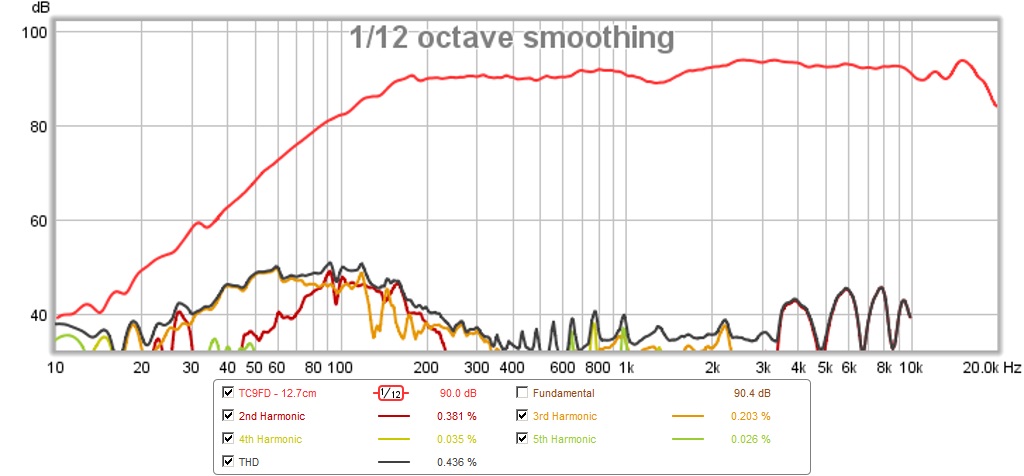
More info here: http://www.diyaudio.com/forums/full...parison-3in-4in-class-full-range-drivers.html
The OB doesn't buy you anything but loss of bass efficiency and extra complexity of having to deal with that OB response that CharlieLaub simulated.
Put it in a trapezoid backed with a Nautaloss "infinite baffle" and you get almost monitor flat response. There is a rise around 2.5kHz that is baffle related but some people like this enhanced "presence".
I would suggest a higher XO around 400Hz to 500Hz. High pass the TC9 to relieve it from too much cone excursion.
You can also get 6 of the $5 polycone woofers from PE and make a SLOB - it sounds very nice and reaches quite low (40hz if I recall).
Here is the measured SLOB response but I had active filters applied.
http://www.diyaudio.com/forums/full-range/249984-cheap-fast-ob-literally-7.html
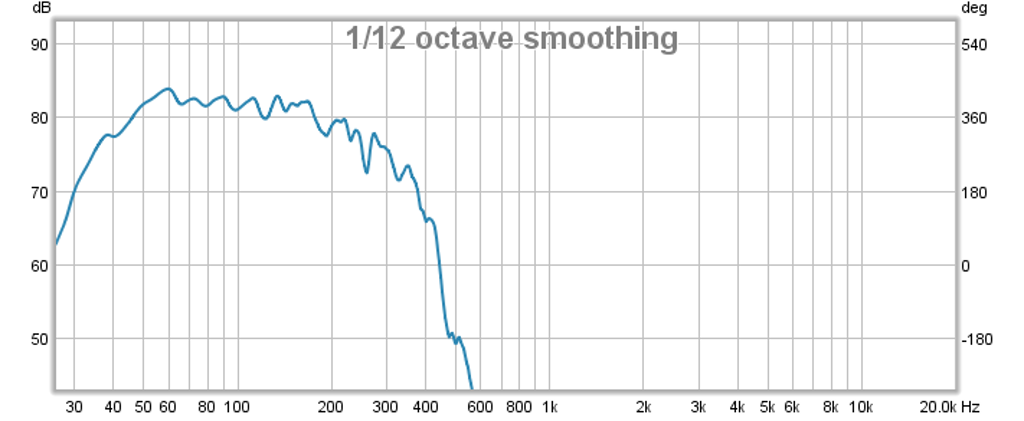
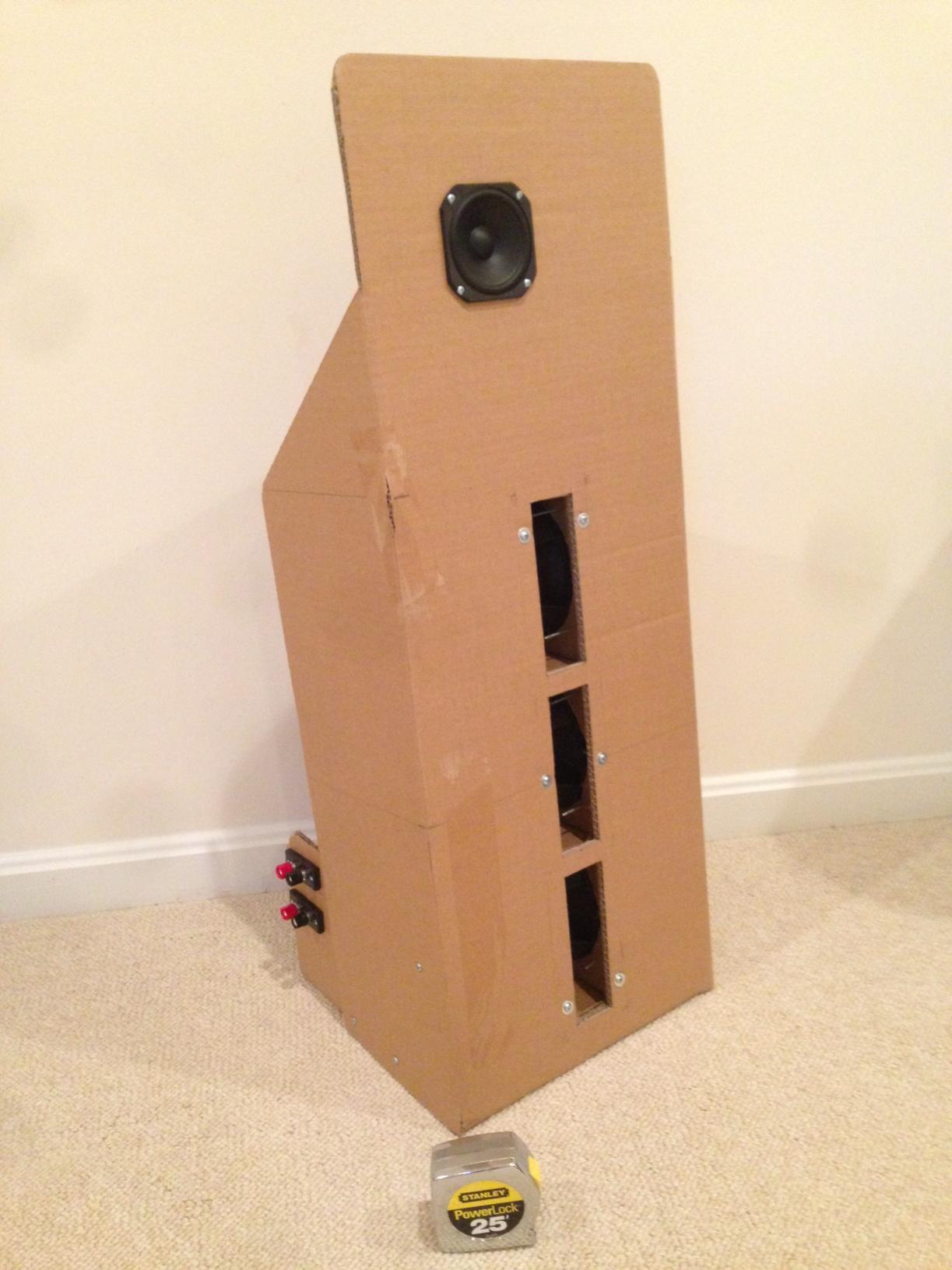
Here is a TC9 and SLOB:

More info here: http://www.diyaudio.com/forums/full...parison-3in-4in-class-full-range-drivers.html
The OB doesn't buy you anything but loss of bass efficiency and extra complexity of having to deal with that OB response that CharlieLaub simulated.
Put it in a trapezoid backed with a Nautaloss "infinite baffle" and you get almost monitor flat response. There is a rise around 2.5kHz that is baffle related but some people like this enhanced "presence".
I would suggest a higher XO around 400Hz to 500Hz. High pass the TC9 to relieve it from too much cone excursion.
You can also get 6 of the $5 polycone woofers from PE and make a SLOB - it sounds very nice and reaches quite low (40hz if I recall).
Here is the measured SLOB response but I had active filters applied.
http://www.diyaudio.com/forums/full-range/249984-cheap-fast-ob-literally-7.html


Here is a TC9 and SLOB:
Last edited:
Nautaloss thread. Just a spiral sealed TL. Match the volume to about 1/2 Vas to 1 Vas of driver to give it enough breathing room for bass generation. If you will be using it as mid and higher with very low excursion, smaller volumes work. Similar to Nautaloss is Dagger sealed TL. Just straightened out 3 sided pyramid. No parallel surfaces.
Nautaloss:
http://www.diyaudio.com/forums/full-range/247598-nautaloss-ref-monitor.html
Dagger:
http://www.diyaudio.com/forums/full-range/268037-fast-tl-8.html#post4192688
Nautaloss:
http://www.diyaudio.com/forums/full-range/247598-nautaloss-ref-monitor.html
Dagger:
http://www.diyaudio.com/forums/full-range/268037-fast-tl-8.html#post4192688
The OB doesn't buy you anything but loss of bass efficiency and extra complexity of having to deal with that OB response that CharlieLaub simulated.
This is not really accurate. If the only thing you got out of an OB system was less bass output and more frequency response irregularities no one would be building them.
Some of the benefits of an OB are: a completely different radiation pattern compared to boxed speakers, a relative lack of panel resonances, a different way to interact with the room and a different way that the room modes are excited, and the possibility for very smooth off-axis response that has a very similar energy content compared to the on-axis response. The last effect listed means that the sound energy that is returned to the listener after interacting with the room will be much like the direct sound, just delayed. The result can be an exceedingly spacious sound stage, and one that remains the same over a wide listening area, if the OB is done right.
On their attributes aside OBs definitely have their own issues, both in terms of achieving anything approaching full bandwidth reproduction, and also in fitting into the type of spaces that many of us have available. I know I sound like a broken record on the subject, but even those of us with decent enough sized rooms, not all are able to dedicate them to classes of speakers with heavy demands on "real estate" and or acoustic treatment.
Some of the benefits of an OB are: a completely different radiation pattern compared to boxed speakers, a relative lack of panel resonances, a different way to interact with the room and a different way that the room modes are excited, and the possibility for very smooth off-axis response that has a very similar energy content compared to the on-axis response. The last effect listed means that the sound energy that is returned to the listener after interacting with the room will be much like the direct sound, just delayed. The result can be an exceedingly spacious sound stage, and one that remains the same over a wide listening area, if the OB is done right.
Oh I totally agree - the OB sound can be beautiful and spacious. I have done it myself many times. Just in the context of the OP wanting to use the TC9 on a smaller baffle like the trapezoid I used with a sealed back chamber - it wasn't going to allow deep enough extension to meet the sub.
I've noticed that the Nautaloss and the FAST are different in that one has an open back and the other doesn't?
You mean the Dagger? It can be open or sealed. Similar performance but open tail TL is heavily stuffed to be aperiodic so kind of like a leaky sealed.
Hey, xrk971 could you answer a question? For a line array is the enclosure volume the same as for a sealed enclosure?
Hey, xrk971 could you answer a question? For a line array is the enclosure volume the same as for a sealed enclosure?
Yes, x the number of drivers. Assuming you want a sealed alignment. You can have aperiodic TL which can work well too and may actually be less volume than a sealed to get the same bass extension.
X- if you mean a line array with each driver seeing its own aperiodic load , that would be a fair bit of fabrication, even in foam core
Well, the open baffle idea is chucked. I've decided to go with a sealed enclosure for the LAT and a transmission line for the TC9FD. I do have a question? I have dimesnions for the sealed LAT enclosure but what I need to know is how much smaller could I make it if I were to pack it with sound absorbing material? And what would be the best material?
Advent did this with the original Advent Loudspeaker which is still a giant killer in my opinion.
Advent did this with the original Advent Loudspeaker which is still a giant killer in my opinion.
On the topic of the TC9 on open baffle, what about 2 or more per side on open baffle to offset the dipole loss and baffle step? Or in a 1.5 arrangement? They're cheap enough that multiples could easily be used...
You get a 3db bump from an MTM arrangement, I think? So in this case you would be building an MM arrangement, of an FRFR arrangement? I think you would have to build it to find out.
On the topic of the TC9 on open baffle, what about 2 or more per side on open baffle to offset the dipole loss and baffle step? Or in a 1.5 arrangement? They're cheap enough that multiples could easily be used...
It's working pretty well for me even without any dsp. I perceive extension down to about 150hz. I'm using a rear firing vifa xt25 to fill out the top octave. Some dsp will elevate the results substantially I believe. This was only an experiment to see if was worth the effort to build 25 per side. I'm gonna need the dsp before I make that decision though.
Wes
Attachments
- Status
- Not open for further replies.
- Home
- Loudspeakers
- Full Range
- Mr. Potatoehead Open Baffle
